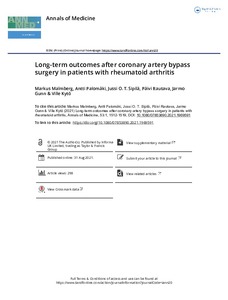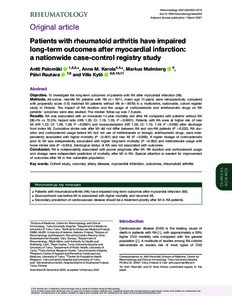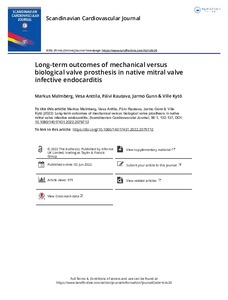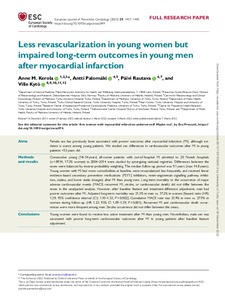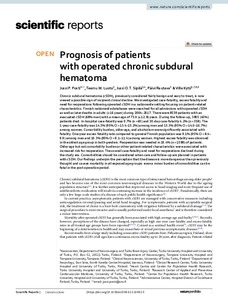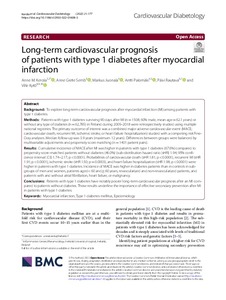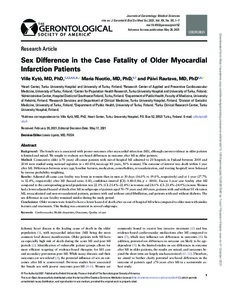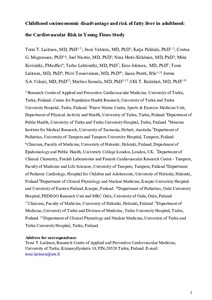Hae
Aineistot 11-20 / 20
Long-term outcomes after coronary artery bypass surgery in patients with rheumatoid arthritis
<p><strong>Objective: </strong>To investigate the long-term outcomes of coronary artery bypass grafting surgery (CABG) in patients with rheumatoid arthritis (RA).</p><p><strong>Methods: </strong>Patients with RA (n = 378) were retrospectively compared to patients without RA (n = 7560), all treated with CABG in a multicentre, population-based cohort register study in Finland. The outcomes were studied with propensity score-matching adjustment for baseline features. The median follow-up was 9.7 years.</p><p><strong>Results: </strong>Diagnosis of RA was associated with an increased risk of mortality after CABG compared to patients without RA (HR 1.50; CI 1.28-1.77; p < .0001). In addition, patients with RA were in higher risk of myocardial infarction during the follow-up period (HR 1.61; CI 1.28-2.04; p < .0001). Cumulative rate of repeated revascularization after CABG was 14.4% in RA patients and 12.0% in control patients (p = .060). Duration of RA before CABG (p = .011) and preoperative corticosteroid usage in RA (p = .041) were independently associated with higher mortality after CABG. There were no differences between the study groups in 30-d mortality or in the post-operative usage of cardiovascular medications.</p><p><strong>Conclusions: </strong>RA is independently associated with worse prognosis in coronary artery disease treated with CABG. Preoperative corticosteroid use and longer RA disease duration are additional risk factors for mortality.Key messagesPatients with rheumatoid arthritis (RA) have impaired long-term outcomes after coronary artery bypass surgery (CABG).Glucocorticoid use before CABG and duration of RA are associated with higher mortality.Special attention should be paid in secondary prevention of cardiovascular disease in RA patients after CABG.</p>...
Digoxin use and outcomes after myocardial infarction in patients with atrial fibrillation
Digoxin is used for rate control in atrial fibrillation (AF), but evidence for its efficacy and safety after myocardial infarction (MI) is scarce and mixed. We studied post-MI digoxin use effects on AF patient outcomes in ...
Patients with rheumatoid arthritis have impaired long-term outcomes after myocardial infarction: a nationwide case-control registry study
<p><strong>Objective: </strong>To investigate the long-term outcomes of patients with RA after myocardial infarction (MI).</p><p><strong>Methods: </strong>All-comer, real-life MI patients with RA (n = 1614, mean age 74 ...
Long-term outcomes of mechanical versus biological valve prosthesis in native mitral valve infective endocarditis
<p>Objectives. To study the long-term outcomes of mitral valve replacement with mechanical or biological valve prostheses in native mitral valve infective endocarditis patients. <br></p><p>Desing. We conducted a retrospective, nationwide, multicenter cohort study with patients aged ≤70 years who were treated with mitral valve replacement for native mitral valve infective endocarditis in Finland between 2004 and 2017. <br></p><p>Results. The endpoints were all-cause mortality, ischemic stroke, major bleeding, and mitral valve reoperations. The results were adjusted for baseline features (age, gender, comorbidities, history of drug abuse, concomitant surgeries, operational urgency, and surgical center). The median follow-up time was 6.1 years. The 12-year cumulative mortality rates were 36% for mechanical prostheses and 74% for biological prostheses (adj. HR 0.40; CI: 0.17-0.91; p = 0.03). At follow-up, the ischemic stroke had occurred in 19% of patients with mechanical prosthesis and 33% of those with a biological prosthesis (adj. p = 0.52). The major bleeding rates within the 12-year follow-up period were 30% for mechanical prosthesis and 13% for a biological prosthesis (adj. p = 0.29). The mitral valve reoperation rates were 13% for mechanical prosthesis and 12% for a biological prosthesis (adj. p = 0.50). Drug abuse history did not have a significant modifying impact on the results (interaction p = 0.51 for mortality and ≥0.13 for secondary outcomes). <br></p><p>Conclusion. The use of mechanical mitral valve prosthesis is associated with lower long-term mortality compared to the biological prosthesis in non-elder native mitral valve infective endocarditis patients. The routine choice of biological mitral valve prostheses for this patient group is not supported by the results.</p>...
Less revascularization in young women but impaired long-term outcomes in young men after myocardial infarction
<p><strong>Background: </strong>Female sex has previously been associated with poorer outcomes after myocardial infarction (MI), although evidence is scarce among young patients.</p><p><strong>Aim: </strong>We studied sex ...
Prognosis of patients with operated chronic subdural hematoma
Chronic subdural hematoma (cSDH), previously considered fairly benign and easy to treat, is now viewed a possible sign of incipient clinical decline. We investigated case-fatality, excess fatality and need for reoperations ...
Long-term cardiovascular prognosis of patients with type 1 diabetes after myocardial infarction
<p>Background<br>To explore long-term cardiovascular prognosis after myocardial infarction (MI) among patients with type 1 diabetes.</p><p>Methods<br>Patients with type 1 diabetes surviving 90 days after MI (n = 1508; 60% ...
Sex Difference in the Case Fatality of Older Myocardial Infarction Patients
<p><strong>Background: </strong>The female sex is associated with poorer outcomes after myocardial infarction (MI), although current evidence in older patients is limited and mixed. We sought to evaluate sex-based differences ...
Childhood Socioeconomic Disadvantage and Risk of Fatty Liver in Adulthood: The Cardiovascular Risk in Young Finns Study
Fatty liver is a preventable cause of liver failure, but early risk factors for adulthood fatty liver are poorly understood. We examined the association of childhood socioeconomic disadvantage with adulthood fatty liver ...
Mortality After Trauma Craniotomy Is Decreasing in Older Adults - A Nationwide Population-Based Study
<p>OBJECTIVE: No evidence-based guidelines are available for operative neurosurgical treatment of older patients with traumatic brain injuries (TBIs), and no population-based results of current practice have been reported. ...
